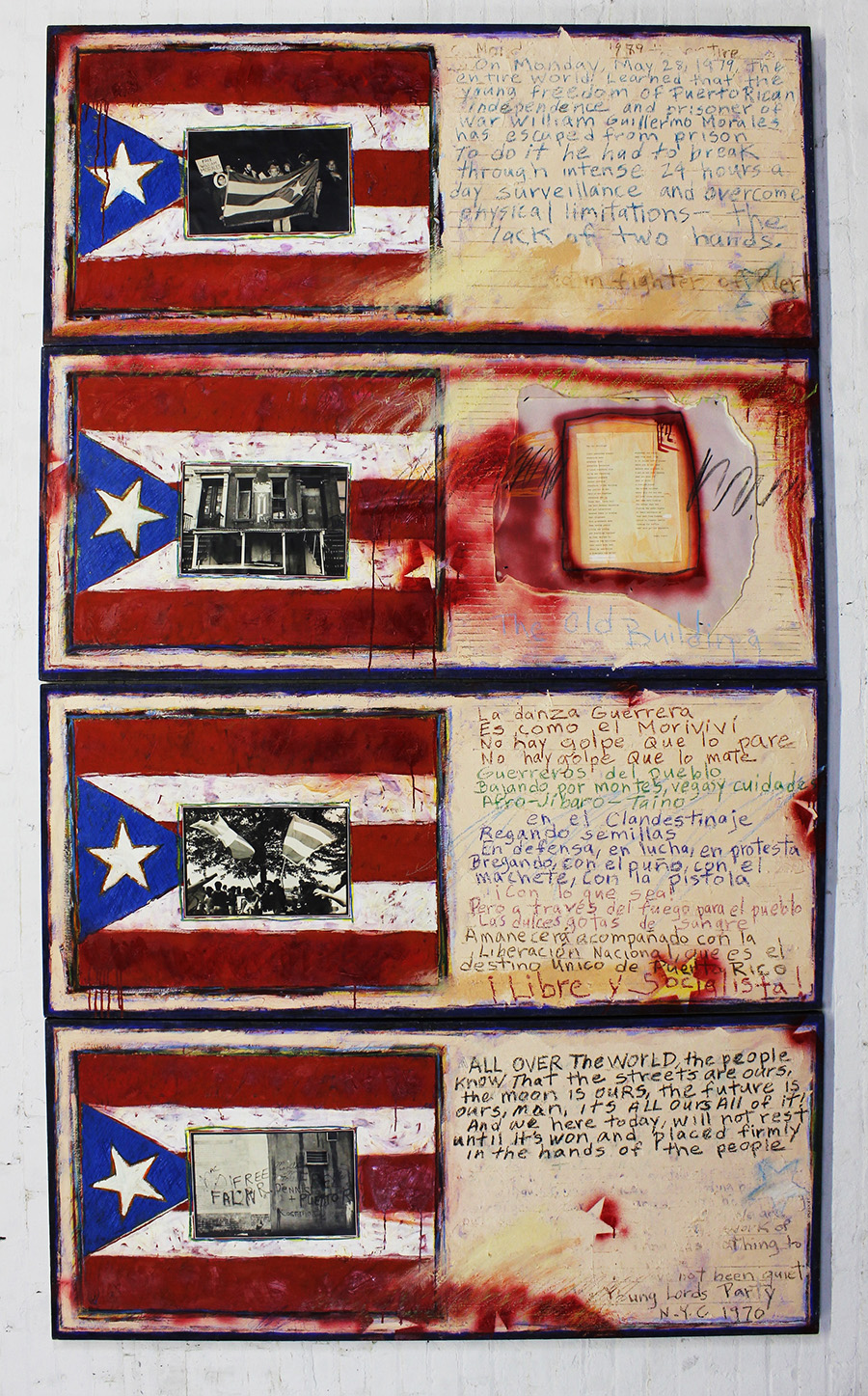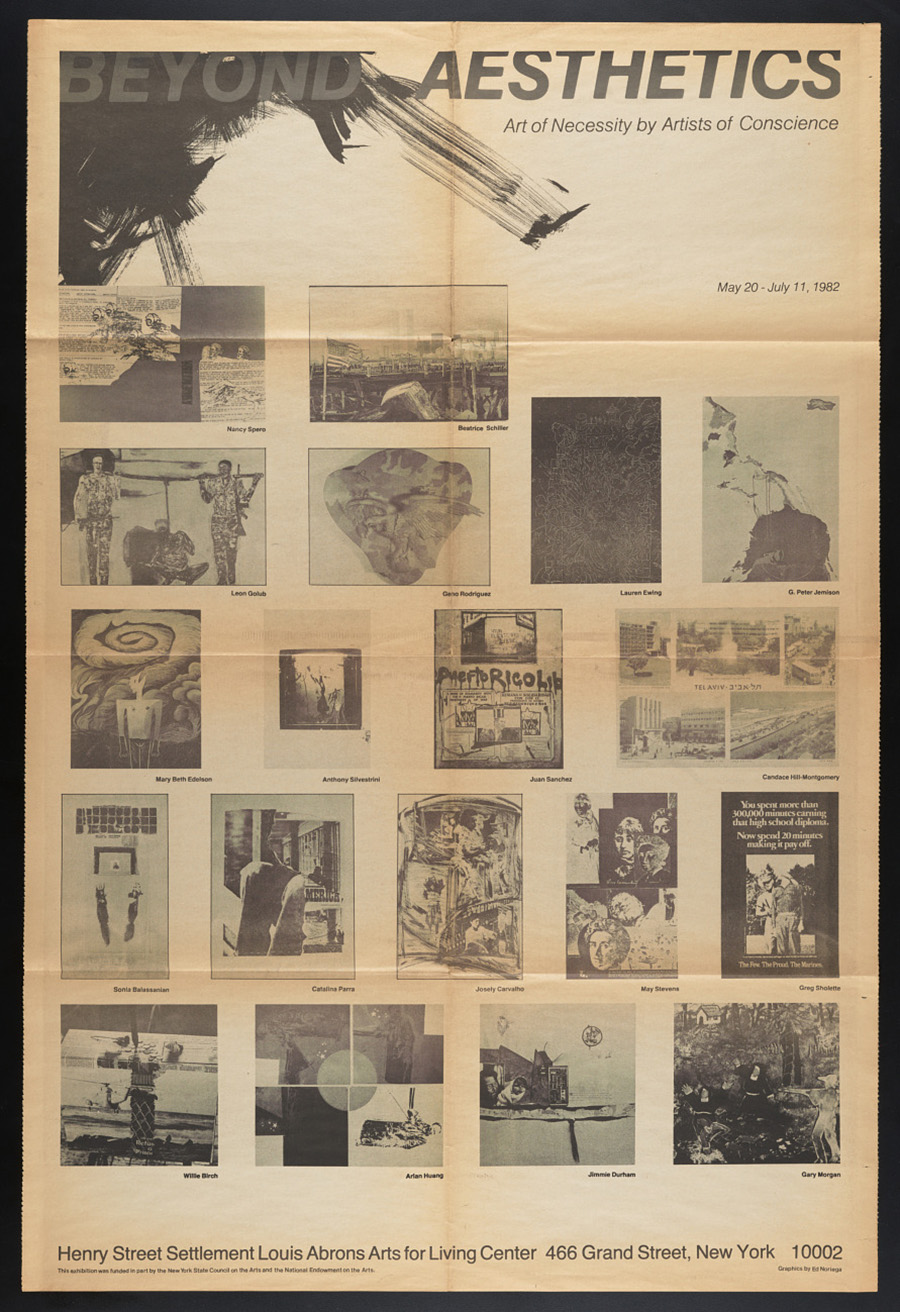Adriana Zavala
Networks
Creativity rarely thrives in isolation. Its richest manifestations emerge instead through collaborative, or at least dialogic, work. This understanding, that artists and thinkers rarely work in disciplinary silos, fuels my research interests. In my first year as the Andrew W. Mellon Professor, I completed revision of a book about postrevolutionary Mexico City, as well as two essays on contemporary AfroLatinx art and artists; the essays testify to the shift in my scholarly priorities toward research and writing about Latinx art’s histories in the United States.

Juan Sánchez, The Bandera (Flag) Series, 1982, oil and mixed-media collage on canvas, Collection of Juan Sánchez, Guariken Arts
The book, Resurrecting Tenochtitlan: Imagining the Aztec Capital in Modern Mexico City (University of Texas Press, May 2023), was collaboratively researched and written with Delia Cosentino of DePaul University. It considers a network of intellectuals—archaeologists, writers, art historians, urbanists, architects, and visual artists—who in the wake of the Mexican Revolution of 1910 undertook a conceptual excavation of the Mexica (Aztec) capital of Tenochtitlan that lies beneath modern-day Mexico City. Resurrecting Tenochtitlan spans the period from 1914 to 1964, bookended by the rediscovery of the main temple pyramid of the Aztec civilization and the opening of the Museo Nacional de Antropología, which offered a distinctly modernist interpretation of Mexico’s Aztec heritage. The book explores how thinkers—from archaeologist Manuel Gamio (1883–1960) to essayist Alfonso Reyes (1889–1959), urbanist Carlos Contreras (1892–1970), and visual artists Carlos Mérida (1891–1984), Diego Rivera (1886–1957), Juan O’Gorman (1905–1982), and others—developed a transformative spatial consciousness rooted in their study of Aztec urbanism. Cross-disciplinary, collaborative, and multimodal approaches allowed them to reimagine Tenochtitlan’s vital relationship to the rapidly modernizing urban landscape. While archaeology in the city’s densely built historical center has, since the 1980s, confirmed the urbanistic connections between the two cities, our book explores how these connections were latent until access to archival materials—16th-century maps, chronicles, and codices—combined with nascent urban archaeology unleashed a new spatial imaginary after 1910: the idea of a mestizo Mexico City. Mestizaje is a racial schema that heralds the union of European and Indigenous ethno-cultural heritage as the fundament of Mexican identity. It relies, however, on Indigenism, a symbolic ideology whereby non-Indigenous-identified intellectuals lay claim to Indigenous heritage, perpetuating the dispossession, ongoing still today, of Mexico’s pueblos originarios. As such while our study is historical, we consider as well how this urbanistic construct continues to have resonance in the present.

Exhibition brochure (page 1 of 2) for Beyond Aesthetics: Art of Necessity by Artists of Conscience, May 20–July 11, 1982, Henry Street Settlement, Louis Abrons Arts for Living Center, New York, Juan Sánchez Papers, circa 1972–2010, Archives of American Art
In addition to finishing Resurrecting Tenochtitlan, I completed an essay, forthcoming in the journal American Art, on Juan Sánchez, a Brooklyn-born (1954), Black Puerto Rican visual artist. Titled “Juan Sánchez’s Counter-Archive,” the essay offers a close reading of his video UNKNOWN BORICUA STREAMING: A Nuyorican State of Mind (2011). The eight-minute work is a digital collage of archival photographs of Puerto Rican migrants alongside artworks by Sánchez and images from his archive. The imagery is set against a flickering, multihued, assertively fractured grid and accompanied by a soundtrack of audio fragments drawn from vanguard musical pieces and politically radical speeches. The effect constitutes, I contend, a counter-archive that interrogates US neocolonialism. Moreover, as a Black Puerto Rican, Sánchez’s video shows how his community’s struggle connects dynamically to other US civil rights and global human rights movements. I had the honor of closing this year’s Wyeth Foundation for American Art Symposium with a screening of the video, in conversation with Sánchez. The symposium, devoted entirely to US Latinx art, was organized in close collaboration with E. Carmen Ramos, chief curatorial and conservation officer at the National Gallery of Art.
My current writing projects include an essay on contemporary AfroLatinx visual artists for the forthcoming “Routledge Companion to African Diaspora Art History,” edited by Dr. Eddie Chambers. The essay explores five artists whose works re-center and affirm the Black diasporic experience within the Latinx political community to challenge reductive racializing schemata that reify Latinx as Brown. I am also writing an essay based on new archival research that considers curatorial projects by Juan Sánchez and Chicana artist Amalia Mesa-Bains (b. 1943). The exhibitions they curated exemplify an ethics of relationship- and praxis of community-building. This ethic is exemplified in Sánchez’s Bandera (Flag) Series, which he included in an exhibition of works by 19 “artists of conscience” at the alternative art space Henry Street Settlement, Louis Abrons Arts for Living Center, in 1982. Like his four-part work, the exhibition challenged the “separate but equal” logic found in the art world’s classification of artists according to ethnicity and race.
Tufts University
Andrew W. Mellon Professor, 2022–2024
During the second year of her professorship, Adriana Zavala will turn her attention to a monograph about feminist AfroLatinx and Latinx artists that will include a collaborative component through incorporation of short-form artist interviews.
